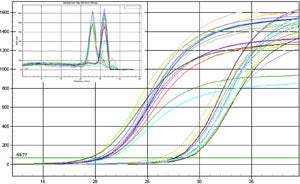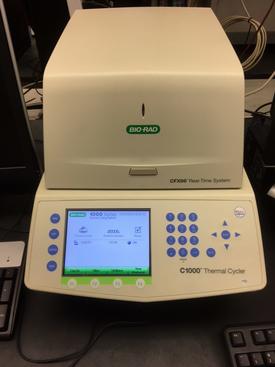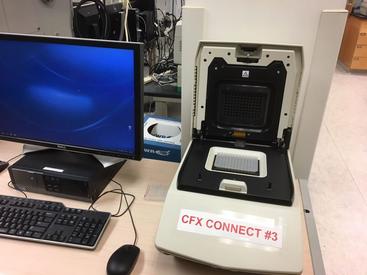Quantitative PCR (qPCR) (user operated)
For usage prices please see our Rates page. To reserve time please go to our Reservation and Billing site.
We maintain four instruments for real time quantitative PCR
Biorad CFX 96, CFX Connect x 3
Applications
- The Genomics Core offers workshops in qPCR theory and practice multiple times per year. Please watch for announcements. If you are new to this method we strongly advise you to attend. It will help to avoid making common mistakes that can be time consuming and very costly.
- Following individual or group training, instruments can be operated in the Core for a modest time-based fee.
- At a linear phase of amplification, the detection of PCR products (and their corresponding mRNAs) is limited only by the quantity of template. Thus, qPCR provides a sensitive and accurate determination of relative or absolute mRNA abundance and gene expression compared to RT PCR, which measures mRNA abundance at a fixed time point.
- qPCR has many applications including absolute and relative gene expression, copy number, miRNA, allelic discrimination, detection of viral or bacterial genomes, and 16S ribosomal genes for metagenomics.
CFX 96
Detects five colors which is useful for Taqman and other probe-based detection methods
CFX Connect (three instruments)
Detects two colors and is designed for SYBR Green detection which is the most common detection method used at UCR
Specifications
- The CFX 96 instrument has optional software to run and interpret high resolution melt curves for allelic descrimination.
- All instruments use a 96-well plate format for quantitative PCR.
- The CFX 96 is capable of multiplexing up to five different fluorphores providing the capability of multiple TaqMan probes.
- All of the instruments detect intercalating dyes such as SYBR Green, which provides a lower cost option utilized by most customers.
- Users can designate up to 6 different primer sets per plate for analysis.
- The CFX and CFX Connect instruments use LED light sources. They are very reliable and reproducible.
- All software is very intuitive.
- Analysis capability includes not only the determination of Cq values, but also the ability to generate histograms and link data across experiments.
- Important note about plates: The Biorad CFX machines require a low profile plate. See our staff about plates and other materials if you are new to qPCR.
- Note that our instruments are calibrated for use with clear films, not caps.
Protocols
Useful resources for qPCR General Theory. There are many resources for learning about qPCR. Also, we have a slide set which describes both the theory and some practical tips that beginning users will find helpful. We offer regular workshops on qPCR theory and practice. Watch for the announcements.
Guidelines for qPCR Reaction Setup and Operation. For a guide to reaction setup, see Guidelines for Biorad qPCR. Although there are many options, we recommend that first-time users obtain clear 96-well plates and clear film to seal plates from Biorad. We stock plates, sealers and reagents at discounted prices. Our inventory is posted outside the Genomics Core lab (2016 Keen Hall).
Software Availability. For the Biorad instruments, software is available for free so that users can analyze data on their own computer. See Core staff for a copy; the software is PC-based only. For Mac users we would suggest using Parallels that permits the running of Mac OS and Windows on the same computer.
Plate Setup Time
A frequent challenge for first-time qPCR users is plate setup. When starting for the first time, please remember to reserve the instrument of your choice and then allow yourself at least one hour to set up your first plate. Once you are used to the setup procedure, it goes much faster.
Troubleshooting
Inconsistent results are typically caused by pipetting errors during plate setup. With small reaction volumes (we recommend 20 or 25ul), such errors can affect your results. This is one reason we recommend, at least at first, that all reactions be done in triplicate. The instruments will provide you with the mean Cq values as well as the standard deviation, so outlying results can be identified.
Templates
Once you have established your conditions, it is important to titrate your cDNA template such that you use the minimum required to obtain Cq values between 10 and 30 cycles. In addition, once your conditions are established, you should make a standard curve of your primers utilizing different concentrations of template. The slope is a measure of efficiency. One hundred percent efficiency would mean that there is a perfect doubling of product at each cycle. Less than 100% efficiency should be accounted for in the final results. The instruments will calculate the efficiency for you, so this is not difficult to do and need only be done once or twice if your efficiencies are near 100%.
Primer Design
Primers should be designed such that the products are typically between 100bp and 200bp, although in practice much longer products may also work well. There is nothing special about qPCR primers. The key is to be sure they do not form dimers, secondary structures or are non-specific. If you are unsure of the specificity, test them first using conventional PCR and examine the product on a gel. A handy set of online tools for such analyses are available at the website for Integrated DNA technologies (IDT).
Getting Help
We are always available to help you design experiments, optimize or interpret data. If you wish to consult please contact the Genomics Core staff.


